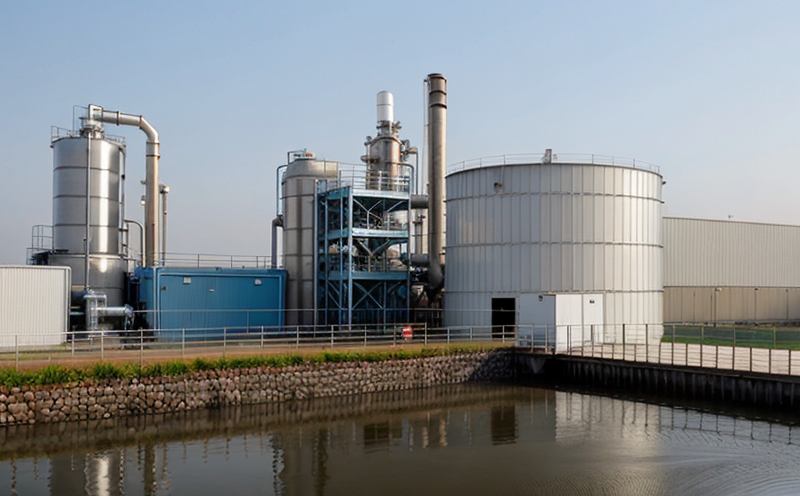EN 872 Suspended Solids Testing in Wastewater
The testing of suspended solids in wastewater according to EN 872 is a critical process for ensuring compliance with environmental regulations and maintaining the efficiency of water treatment processes. This test measures the amount of solid particles that are not dissolved in the liquid phase, which can significantly impact both the quality of effluents discharged into the environment and the operational performance of wastewater treatment facilities.
The importance of this testing cannot be overstated for industrial manufacturing and processing facilities. The presence of suspended solids can lead to a variety of issues such as clogging of pipes and equipment, reduced efficiency in filtration systems, and increased wear on mechanical components. Additionally, high levels of suspended solids in wastewater can cause environmental harm by affecting aquatic life.
The EN 872 standard provides a robust framework for the measurement of suspended solids using various methods including gravimetric analysis and turbidimetry. Gravimetric analysis involves filtering the sample, drying it under controlled conditions, and then weighing the residue to determine the concentration of suspended solids. This method is particularly suitable for samples with high concentrations of suspended solids.
Turbidimetric methods measure the opacity or haziness of a liquid caused by suspended particles using an instrument called a turbidity meter. These instruments emit light through the sample and measure how much light is scattered or absorbed, providing an indirect measurement of the concentration of suspended solids.
The acceptance criteria for this test are based on regulatory limits set by environmental authorities such as the European Union’s Water Framework Directive (2000/60/EC). Compliance with these standards ensures that industrial facilities contribute to sustainable water management and protect aquatic ecosystems. By adhering to these regulations, industries can mitigate their environmental impact while maintaining operational efficiency.
In summary, the testing of suspended solids in wastewater according to EN 872 is essential for ensuring compliance with international standards and protecting both industrial operations and the environment. Understanding the methodology behind this test allows quality managers, R&D engineers, and other stakeholders to make informed decisions about process optimization and regulatory adherence.
Why It Matters
The importance of suspended solids testing in wastewater cannot be overstated for several reasons. Firstly, high concentrations of suspended solids can lead to significant operational challenges within industrial facilities. For instance, excessive levels may cause blockages in pipes and filters, leading to downtime and increased maintenance costs. Secondly, these particles can settle in reservoirs and settling tanks, reducing their efficiency over time.
Moreover, the presence of high concentrations of suspended solids in effluents discharged into natural water bodies can have severe ecological consequences. These particles can clog fish gills, affect photosynthesis in aquatic plants, and disrupt entire ecosystems. Therefore, monitoring and controlling suspended solids levels are crucial for maintaining environmental health.
The testing process itself is not only a compliance requirement but also an integral part of the continuous improvement cycle within industrial facilities. By regularly measuring suspended solids, plant operators can identify trends and take proactive measures to address any issues before they escalate into larger problems. This data-driven approach enhances operational efficiency while minimizing environmental impact.
In conclusion, the significance of suspended solids testing lies in its ability to bridge the gap between industrial operations and environmental protection. By adhering to standards like EN 872, industries contribute positively to sustainable development goals, ensuring long-term viability both for themselves and their surrounding ecosystems.
Scope and Methodology
The scope of suspended solids testing according to the European standard EN 872 encompasses a wide range of applications across various sectors, including chemical processing, food & beverage manufacturing, pharmaceutical production, and more. The primary objective is to quantify the amount of solid particulates in wastewater samples, which helps facilities understand their discharge impacts on receiving waters.
The methodology involves several key steps that ensure accurate measurement results. Initially, a representative sample must be collected from the wastewater stream. This sample should reflect typical conditions found within the facility and should not be biased by localized variations or anomalies. Once collected, the sample needs to be transported under controlled temperature conditions to prevent any changes in its physical properties.
There are two main techniques used for measuring suspended solids: gravimetric analysis and turbidimetry. Gravimetric methods involve filtering a known volume of wastewater onto a filter membrane, drying it thoroughly at 103 ± 2°C until constant weight is achieved, and then weighing the residue to determine its mass concentration. Turbidometric methods rely on measuring light scattering or absorption through the sample using specialized instrumentation.
The acceptance criteria for both methodologies are derived from international standards such as ISO 7624 (Gravimetric Methods) and ASTM D1914 (Turbidometric Methods). These standards define permissible limits based on the intended use of the treated water. For instance, stricter limits apply to potable water supplies compared to industrial discharge streams.
To summarize, the scope and methodology for suspended solids testing according to EN 872 involve careful sampling procedures followed by either gravimetric or turbidometric analysis depending on the nature of the wastewater. Compliance with these standards ensures accurate quantification which is vital for both operational efficiency and environmental stewardship.
Industry Applications
- Chemical Processing: Monitoring suspended solids helps maintain optimal reaction conditions in reactors, preventing clogging of pipes and valves.
- Food & Beverage Manufacturing: Ensures product quality by minimizing contamination from particulates that could affect taste or texture.
- Petrochemical Industry: Protects sensitive equipment like heat exchangers and compressors from fouling, extending their lifespan.
- Pharmaceutical Production: Guarantees sterility of products by reducing the risk of microbial growth in contaminated water streams.
The data generated during suspended solids testing plays a crucial role across multiple stages of production. From raw material handling to final product packaging, precise measurements ensure consistency and quality at every step. Additionally, regulatory compliance ensures that these processes meet legal requirements, thereby safeguarding public health and environmental integrity.





